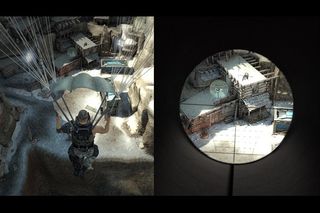E3 07: Army of Two - hands-on
We crash through this aggressively deep, unsubtly political two-man shooter
Customization also affects which merc your enemies pay the most attention to; if one of you has a gun that dwarfs what your partner is carrying, for example, then they'll focus their fire on him. Luckily, since you can mix and match gun parts - stocks, barrels and the like - you can also stick a big, bulletproof shield on your oversized shooter, making it a little safer for you to draw fire.
Another thing that determines how enemies react to you is "Aggro," the game's unique aggression-balancing system. Running around with guns blazing, killing dudes and blowing stuff up will build up your Aggro, drawing enemy fire toward you and away from your partner. If your partner starts getting aggressive as well, some of the Aggro is transferred back to him, and so on. If you manage to max out your Aggro, however, you'll start glowing red and dealing out four times the damage. Meanwhile, your partner will glow blue, indicating he's just entered stealth mode - which means enemies will completely ignore him. This makes it easy for him to sneak around to a flanking position and blow unsuspecting baddies away while they're training their fire on you. If you'd like to hurry this up, your partner can feign death for a little while, which will instantly transfer all the Aggro to you.

Of course, the team dynamic isn't limited to Aggro strategies. You'll also depend on each other when you encounter things like high obstacles; in cases like this, one player can give the other just enough of a boost to see over it, and if the coast isn't clear, the boostee can stand on the booster's shoulders and clear out the opposition. Then, boostee can climb on top of the obstacle, pull the booster up after him, and both can clamber over into the now-safe area. Teamwork also comes into play when you encounter a sharp drop, as one merc can rappel down a rope while the other one holds it.
Sign up to the GamesRadar+ Newsletter
Weekly digests, tales from the communities you love, and more

Oh, that's why the Stellar Blade devs were terrified by demo players: one fan's spent "about 60 hours" maxing Eve's skill tree before the action RPG is even out

A new Taylor Swift song mentions GTA, but some remember it mentioning Baldur's Gate 3, Final Fantasy 14, and more in hilarious Twitter trend
Most Popular




